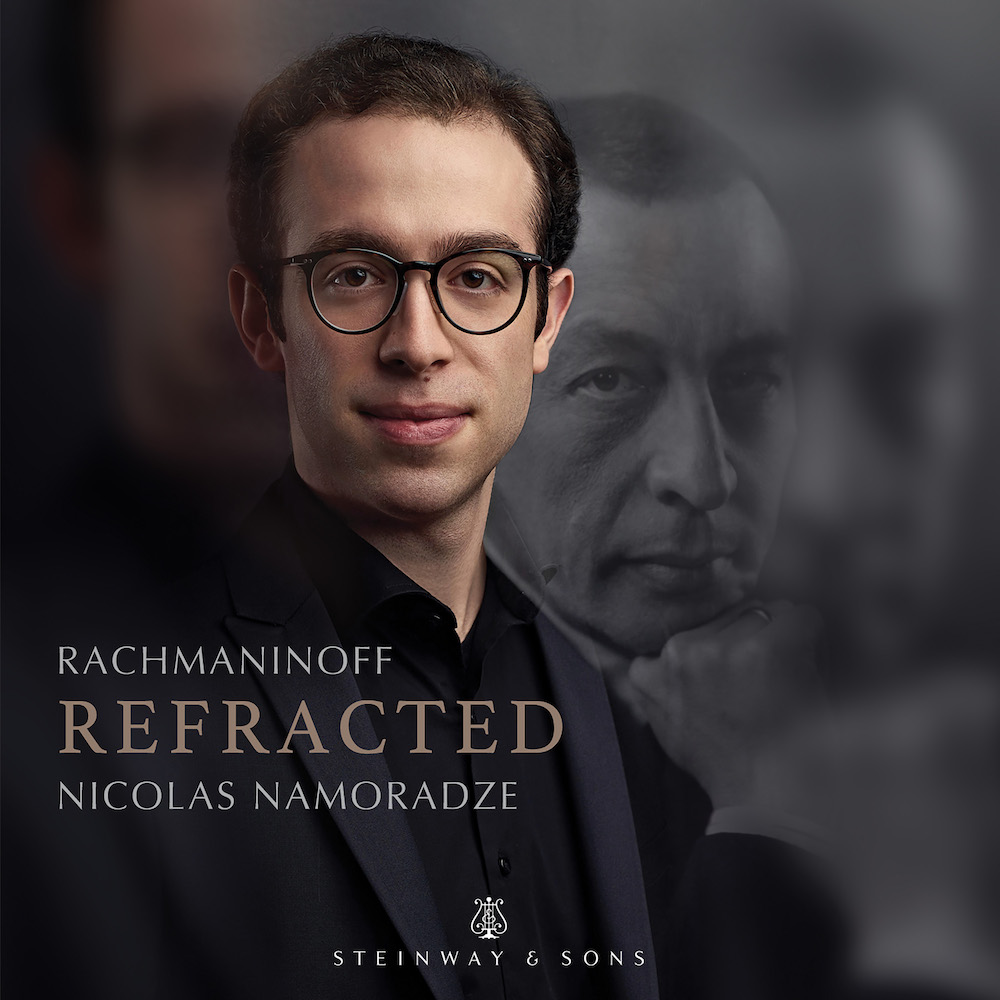RAchmaninoff Refracted
Nicolas Namoradze
Pianist and composer Nicolas Namoradze’s new album, Rachmaninoff Refracted, explores the oeuvre of Sergei Rachmaninoff on the occasion of his 150th anniversary year. Namoradze approaches his work from several angles: as a pianist, composer, transcriber, and one whose music is arranged. 
On October 6, 2023 STEINWAY & SONS releases Rachmaninoff, Refracted (STNS 30204). This new album by pianist/composer Nicolas Namoradze celebrates the 150th anniversary of Sergei Rachmaninoff's birth.
In his liner notes for the album Namoradze writes: Rachmaninoff’s monumental Piano Sonata No. 1 constitutes the program’s center of gravity, and is complimented by one of his most celebrated transcriptions, as well as a set of recent arrangements and reflections on his work—a testament not only to the continued centrality of his musical output in the core repertory but also the freshness of his oeuvre and the new forms and guises in which it appears today.
Opening the album is Rachmaninoff’s iconic arrangement of the Gavotte from the Third Partita for Solo Violin by Johann Sebastian Bach (1685-1750). The Gavotte is one of three movements that Rachmaninoff transcribed in 1933, along with the Preludio and Gigue. In the sprightly, elegant Gavotte, rather than simply realizing Bach’s string writing on the keyboard Rachmaninoff adds several polyphonic layers, yielding not only considerably denser textures but also a plethora of new harmonic motions. This complexity reflects his fascination with the counterpoint of Bach—a significant influence on Rachmaninoff’s piano writing.
The next work on the program is my arrangement for solo piano of the Adagio from Rachmaninoff’s Symphony No. 2 in E minor, Op. 27. Since its highly successful premiere in 1908 the symphony remains among Rachmaninoff’s most celebrated musical statements, and the third movement, Adagio, is emblematic of many features that define his compositional language, including enchantingly expansive melodies, a rich harmonic palette, searing climaxes, and lush, full textures. While adhering strictly to the thematic and harmonic material of the original, this arrangement is less a strict transcription and more a reimagining of the movement for the piano, taking a generally liberal approach with reworking the textures in order to create a pianistically idiomatic piece. The piano writing is informed both by Rachmaninoff’s compositional style as well as my own approach to keyboard texture.
Another arrangement of Rachmaninoff’s work follows: the Vocalise, Op. 34 No. 14, transcribed for solo piano by Zoltán Kocsis (1952-2016). Among Rachmaninoff’s most widely performed songs, the Vocalise is something of an anomaly given its lack of text (as suggested by its title), with the singer vocalizing a sorrowful, haunting vocal line. This feature has also made the song especially amenable to arrangements, with multiple versions in existence for a variety of instrumentations. Kocsis’s solo piano transcription remains generally faithful to the original texture until the final reprise of the opening material, which is adorned by crystalline, gently fluttering arabesques in the upper registers of the keyboard.
The Vocalise makes way for the centerpiece of the disc, Rachmaninoff’s Piano Sonata No. 1 in D minor, Op. 28. Completed in 1907, it is his most symphonic creation for the piano, and closest in spirit to another work he was writing during this period—the Symphony No. 2. Despite several revisions and attempts on the part of the composer to condense the work, the sonata remains colossal in scale and breadth—reflecting his original programmatic conception of the piece, based on the epic of Faust. According to accounts of his contemporaries, Rachmaninoff had intended the three movements to depict Faust, Gretchen and Mephistopheles in turn, thus taking after Liszt’s Faust Symphony and the Sonata in B minor. The brooding opening of the first movement makes way for a variety of thematic material at times agitated and anguished, at times resolute and valiant, alternating in a heroic struggle. The lyrical second movement, with its soaring melodies and beguilingly rich textures, provides some respite before the diabolical finale: a macabre tempest suffused with strains of the Dies Irae chant which, despite a number of attempts to emerge from the depths with references to the previous movements, ends cataclysmically.
I wrote Memories of Rachmaninoff’s Georgian Song, the final work on the album, for the sesquicentennial celebrations. It is based on an early song by Rachmaninoff, Oh, do not sing for me, Op. 4 No. 4, set to a poem by Pushkin and known as the “Georgian Song.” The song’s expressively winding and melismatic opening, highly reminiscent of Georgian folk music yet an original creation of Rachmaninoff’s, introduces the following verse:
Do not sing for me, my beauty,
Your sad Georgian songs of yore;
For they wake deep from my memory
Another life and a distant shore.
Memories of Rachmaninoff’s Georgian Song is neither an arrangement nor a paraphrase, but rather the musical equivalent of a faint, dreamlike recollection—an allusion to the topic of the original song itself. The work opens with a sparse figuration where strains of the song’s melody are occasionally suggested, as if from far away. A gradual thickening of the texture leads to a more recognizable utterance of Rachmaninoff’s thematic material before the work retreats back into the realm of distant memory.
— Nicolas Namoradze
“Namoradze played with nuance, ease, and refinement...a type of musical searching and exploration found only in the playing of themost intelligent of pianists.”
Calgary Herald
“Namoradze possesses that slightly capricious, free manner of playing that ideally suited the vocal melodic lines... With no apparent effort he was able to create an infinite variety of colors and shades of dynamics, from the most delicate to thunderous, but never banging. And what’s even more important was the singing quality of his sound, which was also refined, subtle, selective in all registers of the piano and dynamic spectrum.”
ConcertoNet.com
“Namoradze’s dynamic palette was varied and well-judged without allowing the sonority to become harsh… Namoradze’s leisurely paced reading ran the gamut from soft lightness to bold thrusts, his sense of the score’s deep romanticism strongly imprinted… Namoradze is clearly an impressive young musician with a rock-solid technique.”
South Florida Classical Review
ALBUM CREDITS
Rachmaninoff, Refracted / Nicolas Namoradze • STNS 30204
Release Date: 10/06/2023
Produced with support from the Honens International Piano Competition.
Recorded October 17 - 19, 2022 at Bella Concert Hall, Calgary.
Producer: Denise Ball
Recorded, edited, mixed, and mastered by James Clemens-Seely.
Executive Producers: Eric Feidner, Jon Feidner
Art Direction: Jackie Fugere
Design: Cover to Cover Design, Anilda Carrasquillo
Photos of Nicolas Namoradze: Nathan Elson
Production Assistant: Renée Oakford
Piano Technician: Matthew Moffatt
About the Artist
Pianist and composer Nicolas Namoradze came to international attention in 2018 upon winning the triennial Honens International Piano Competition in Calgary, Canada—among the largest prizes in classical music. His recitals around the globe have been met with universal critical praise, and recent album releases have received extraordinary accolades, including the Choc de Classica, Record of the Month in Limelight, Instrumental Disc of the Month in BBC Music Magazine, Editor’s Choice in Gramophone, Editor’s Choice in Presto Classical and Critics’ Choice in International Piano.

Among the most critically acclaimed musicians of his generation, Namoradze was bestowed the 2020 & 2021 Young Pianist Award by the UK Critics’ Circle, which called him “very much more than a top-flight pianist.” His current activities include residencies at the Konzerthaus Dortmund, Antwerp Symphony Orchestra and the Dresdner Philharmonie; recitals at concert halls including New York’s Carnegie Hall, London’s Wigmore Hall, Konzerthaus Berlin and the Tokyo Bunka Kaikan; festival appearances at Tanglewood, Banff, Gstaad, Santa Fe and more; and performances with orchestras including the London Philharmonic, Budapest Festival Orchestra, Sinfonieorchester Basel and the Orchestra RAI, with conductors such as Iván Fischer, Hans Graf, John Axelrod, Karina Canellakis and Ken-David Masur.
After completing his undergraduate in Budapest, Vienna and Florence, Namoradze moved to New York for his master’s at The Juilliard School and his doctorate at the CUNY Graduate Center. His teachers and mentors have included Emanuel Ax, Yoheved Kaplinsky, Zoltán Kocsis, Matti Raekallio, András Schiff and Eliso Virsaladze in piano, and John Corigliano in composition. He currently pursues postgraduate studies in neuropsychology at the Institute of Psychiatry, Psychology and Neuroscience at King’s College, London, where his research interests include the effects of mental practice and mindfulness on musical performance. Namoradze is the author of the book “Ligeti’s Macroharmonies”, published by Springer in the Computational Music Science series, and his compositions are published by Muse Press.
About Steinway & Sons label
The STEINWAY & SONS music label produces exceptional albums of solo piano music across all genres. The label — a division of STEINWAY & SONS, maker of the world’s finest pianos — is a perfect vessel for producing the finest quality recordings by some of the most talented pianists in the world.